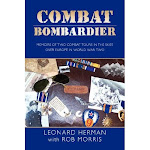Marshall Dullum is 79 years old, a modest man who, like most veterans, would be the last to tell you that he is a hero. The Idaho Falls resident, originally from Minnesota, spent five years in the United States Air Force, beginning in 1946 during the German Occupation and ending as a radio operator on one of the largest prop-driven bombers ever built-- the magnificent sixty-ton, 9,000 horsepower B-29 Superfortress.

Figure 1 S/Sgt. Marshall A. Dullum, Front Row, Second From Left
He put his college education on hold to serve his country and ended up never finishing. At a time when many young men were pursuing education and careers, he was flying high-level combat missions in the dangerous skies over North Korea in what many historians call ‘the forgotten war’.
Dullum joined the Merchant Marine directly out of high school, and served about a year before enlisting in the Air Force in 1946. After training in the States, Dullum was shipped overseas and was stationed at a former German air base near Vienna, Austria. Originally in the motor pool, he yearned for more excitement, so when a friend told him about a chance to apply for radio operator school, he jumped on it. After finishing ground operator school, he proceeded to airborne radio school and ended up flying as a crewman on C-47s, the military equivalent of the DC-3.
In 1949, Dullum was discharged and returned to California to pursue his college studies. However, as a member of the reserves, he was called up only ten months later. “I wanted to go to college, but the Strategic Air Command had a lot of pull,” he remembers. “There were a lot of guys in training who you could tell by their age were probably World War Two veterans.”
By January, 1950, Dullum was training in California to be a radio operator on the massive Boeing B-29 Superfortress bomber. “It was a beautiful plane,” he remembers. “I loved it. It was the biggest four-engine plane the United States had at the time, other than the B-36.” It could fly at up to 400 mph at well over 30,000 feet, and it could carry two thousand pounds of bombs up to 5,000 miles. Defensively, the Superfortress bristled with ten fifty-caliber machine guns of 1,000 rounds each. Later models also had a 20 mm cannon in the tail.
Production of B-29s had been discontinued at the end of World War Two, after the manufacture of a little over 3,600 planes. However, the new Strategic Air Command retained the bomber for use in the postwar years. In 1950, the B-29 was reclassified as a medium, rather than a heavy, bomber because its long-range duties had been taken over by the newer Boeing B-36 and B-50. On June 25, 1950, North Korea invaded South Korea, and President Harry Truman committed U.S. forces to protect the South. The B-29 began bombing shortly thereafter, both in tactical roles against troop concentrations, bridges, and supplies and against strategic targets such as railroad marshalling yards in North Korea.
Dullum ended up in the 23rd Bomb Group, stationed at Yokota Air Force Base near Tokyo, Japan. He was one of a crew of eleven men, five officers and six enlisted men. “They were a wonderful crew,” he remembers. “The enlisted men lived in wooden barracks, and we had no extra duties, just flying. Very occasionally, we got bacon and eggs for breakfast, but things were still pretty tight in Japan after the war.” His crew included four officers--the aircraft commander (commonly known as chief pilot), pilot, Navigator, Bombardier, V/O, and six enlisted men: an engineer, a central fire control specialist, right and left waist gunners, radio operator and tail gunner.
Dullum’s crew flew the same, un-named B-29 on all missions. The plane, a World War Two veteran, had flown bombing missions over Japan. In Dellum’s crew photo, one can see bombs painted under the pilot’s window, one for each mission the old plane has flown. There are 92 bombs painted on the plane. Three of the bombs are painted white. These blank bombs, Dullum explains, are from “fish-feeding missions”, when for some reason the plane was unable to bomb the target and had to dump the bomb load at sea, since planes were not allowed to return to base loaded.
Missions could last as long as thirteen hours. During missions, Dullum manned the radio compartment. He also dropped chaff (aluminum strips that confuse radar), and armed the bombs. “When we dropped the bombs,” he remembers, “we’d drop the cabin pressure and I’d go into the bomb bay and pull the arming pins so the impellors would turn. I spent a lot of time pulling pins in the forward bomb bay and working on equipment in the aft set. Never once did we have clusters or individual bombs hang up, thanks to a very good crew that took pride in their work.” With radiomen on the other ships, he sent out radio signals to jam North Korean anti-aircraft batteries.
“When the flak batteries found our range anyway, the aircraft commander would come on the interphone and say, ‘What the heck are you doing, Dullum?!’
“‘It could have been worse, sir, we didn’t get hit,’ I’d say.”
“‘Why did we even bring you along?’ he’d ask, and my smart answer was ‘to empty the honey bucket, sir.’”
“Thirteen-hour missions made the honey bucket a necessity. The rule was, the first to use it had to empty it for the rest of the mission. “On mission day, I wouldn’t drink any coffee. I wouldn’t even put milk on my cereal,” Dullum chuckles.
“Our main worry was the Mig-15 jet fighters, but they didn’t want to get too close to us. We had a lot of firepower on each plane. The Migs were a lot faster than we were. But they didn’t like the high altitude. We bombed at 38,000 feet. We also had to worry about flak from anti-aircraft batteries down below. Thankfully, nobody got shot down. About the time I left, the Air Force began flying all their missions at night. Daylight bombing was just becoming too risky. The anti-aircraft fire was becoming more accurate and the enemy fighters were getting better.”

After his one-year redeployment, Dullum returned to California but came up short of finishing college. He spent his working years as a policeman and as an inspector of various weights and measures devices for petroleum, electricity and food. Idaho’s low cost of living attracted Dullum and his wife to Idaho Falls several years ago, and they are enjoying becoming part of the community.
Looking back, Marshall Dullum thinks fondly of the giant B-29 Superfortress, and laments the fact that at present, there is only one B-29 that is still flyable in the world. He had a chance to visit this bomber, named ‘Fifi’, in California a few years back, and sat in his old position in the bowels of the great ship. “It felt just as big as ever”, he remembers.
“Thanks to the Good Lord and a super crew, we experienced very few problems. I have a great love and respect for the Boeing B-29 Superfortress, and for the C-47.”
Just as Americans need to remember to love and respect veterans.








4 comments:
Great story Rob, you're right about it being the forgotten war. How many B.29s got shot down by Migs in Korea? That last pictures exemplifies what an elegant plane the B29 was.
Great question, Richard. Here are the statistics:
--When the Korean War ended on July 27, 1953, the B-29s had flown over 21,000 sorties, nearly 167,000 tons of bombs had been dropped, and 34 B-29s had been lost in combat (16 to fighters, four to flak, and fourteen to other causes). B-29 gunners had accounted for 34 communist fighters (16 of these being MiG-15s) probably destroyed another 17 (all MiG-15s) and damaged 11 (all MiG-15s). Losses were less than 1 per 1000 sorties.
Love your site. Just a few observations:
The B-36 was built by Convair, not Boeing. The B-36 was also massively bigger than the B-29 and B-50
The B-50 was a beefed-up B-29 and externally almost indistinguishable from the B-29 though it's most obvious difference was a larger tail.
There was negligible difference in size, but the B-50 was far more powerful than the B-29 and could achieve a speed of just UNDER 400mph, so I am puzzled at the claim that the B-29 could exceed 400mph. The official top speed of the final B-29's was 310knots (357mph), well below the claim of 400+mph.
I can't find any difference in bomb load between the '29 and '50.
I experienced the B-29 from the wrong end, personally as a child when our family were interned in Tokyo as enemy nationals throughout WW2 and experienced the Mar9-10 raid which killed more people than the Atom bomb. Probably well over 90% of those killed were non-combatants including around 35,000+ children. It was a low-level incendiary raid that sickened many of the aircrews who could not get the smell of burning flesh out of their uniforms. Gen Curtis LeMay commented at the time that if the US were to lose the war, he (LeMay) would be convicted as a war criminal.
During the Korean war I went to an American boarding school very close to Johnson AFB and not much farther than Tachikawa AFB -- I could reach either of them easily on my bicycle -- (both on the outskirts of Tokyo). Certainly near enough to hear, very loudly, the crash of a fully-laden B-29 (so we were told by a USAF soldier).
B-29 losses were low because after the arrival of jet fighters, their sorties were restricted to night missions (supply interdiction?). Daylight sorties were high-altitude recon, mainly, I believe, by B-50's.
Cheers
norm luke
Wow, Norm. What an amazing entry from you!! i wish i'd seen it sooner, it's now November 2008.
Get in touch with me if you see this.
Rob
Post a Comment